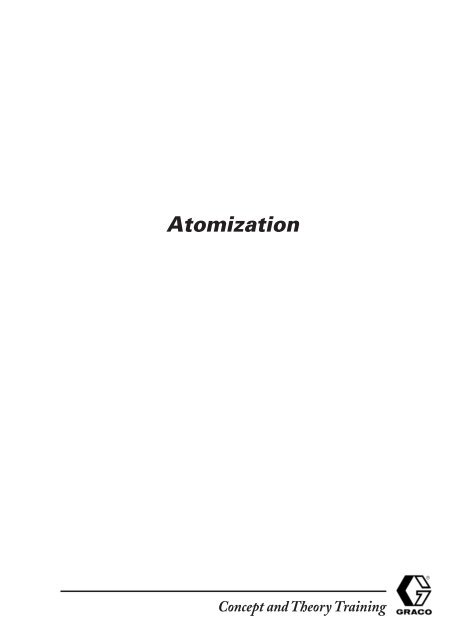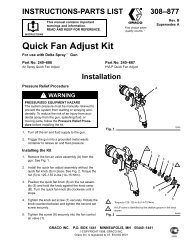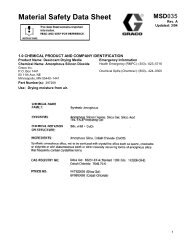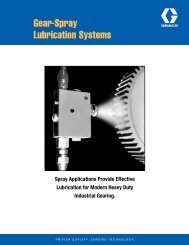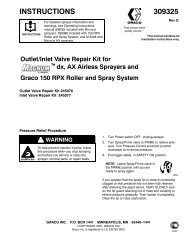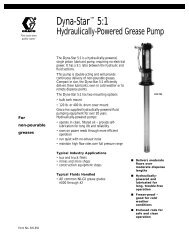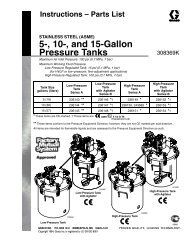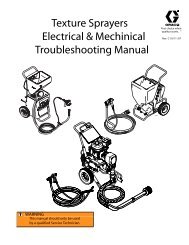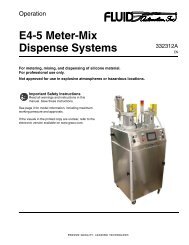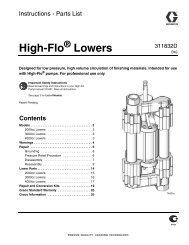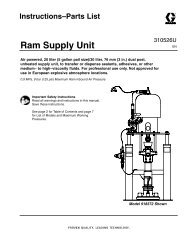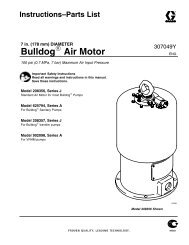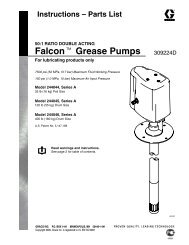Atomization - Graco Inc.
Atomization - Graco Inc.
Atomization - Graco Inc.
Create successful ePaper yourself
Turn your PDF publications into a flip-book with our unique Google optimized e-Paper software.
<strong>Atomization</strong>®Concept and Theory Training
Table of ContentsIntroduction ........................................... 1Module Overview .................................................... 1How to Use This Module ......................................... 1<strong>Atomization</strong> Fundamentals..................... 3Learning Objectives ................................................. 3<strong>Atomization</strong>, Sprays, Droplets, andSurface Tension ........................................................ 3Fluid Properties Affecting the Spray ....................... 5<strong>Atomization</strong> Processes ........................... 9Learning Objectives ................................................. 9Pressure (Airless) <strong>Atomization</strong>................................ 9Air (Airspray) <strong>Atomization</strong>................................... 10Centrifugal <strong>Atomization</strong>........................................ 11Electrostatic <strong>Atomization</strong> ...................................... 12Ultrasonic <strong>Atomization</strong> ......................................... 13Achieving Desired <strong>Atomization</strong>............................. 14GRACO, INC.P.O. Box 1441Minneapolis, MN 55440-1441©1995 <strong>Graco</strong>, <strong>Inc</strong>., Form No. 321-027 8/95 Printed in U.S.A.i<strong>Atomization</strong>®
IntroductionWelcome to <strong>Atomization</strong>, a learning module in <strong>Graco</strong>’s basic concept and theory sales trainingcurriculum. Your understanding of this information provides the basis for further study on specific<strong>Graco</strong> products. Your ability to successfully promote and sell <strong>Graco</strong>’s products depends in part onhow well you learn the basics and then apply this knowledge to addressing your customers’ needsfor <strong>Graco</strong> equipment.While this curriculum best fits the requirements of <strong>Graco</strong> and distributor sales people, it will alsobenefit anyone whose job function depends on knowledge of <strong>Graco</strong>’s products.Module OverviewThis module orients you to the process of atomization and describes five basic formsof atomization.How to Use this ModuleThe curriculum consists of a series of self-study modules. As the term self-study implies, you workthrough the materials on your own at a comfortable pace. Plan sufficient time (approximately 30minutes) to complete at least one section of a module in a working session.This module combines a variety of features that makes the learning process convenient andproductive:• Learning objectives• Text• Charts, illustrations• Progress checks• Additional resourcesLearning ObjectivesEach section of material offers a set of learning objectives. Read the objectives and use them toguide you to the most important concepts. After you finish each section and before you completethe progress check, reread the objectives to confirm that you understand the key concepts.TextDefinitions, examples, and explanations comprise the learning module text. Read it carefully andreturn for review if necessary.®<strong>Atomization</strong> 1
Charts, IllustrationsAn important element of any instruction is visualizing the concepts. This module contains graphicsand illustrations to enhance the text material. Wherever appropriate, the module also containscharts that help you organize or summarize information.Progress ChecksProgress checks are self-tests that provide reinforcement and confirm your understanding ofimportant topics. After completing each section of the module, return to review the objectives,and then work through each of the progress check items. Upon completion, check your answersagainst those provided. If you answered any incorrectly, return to the text and reread thepertinent information.Additional ResourcesThis module may refer you to other documents or sources that expand on the concepts covered inthe module. The reference will include the name of the source and how you can obtain it.2<strong>Atomization</strong>®
<strong>Atomization</strong> FundamentalsLearning ObjectivesYour effectiveness with customers depends in part on your ability to knowledgeably and confidentlydiscuss their needs, your products, and competitors products. The concepts of atomizationform part of the foundation necessary for future learning about how guns operate and how to promote<strong>Graco</strong>’s products’ features and benefits. After completing this section on basic terms, you willbe able to:• Distinguish between atomization and sprays.• Describe the property of liquid surface tension.• Relate fluid properties to their effects on atomization.<strong>Atomization</strong>, Sprays, Droplets, and Surface Tension<strong>Atomization</strong> refers to the process of breaking up bulk liquids into droplets. Common homeatomizers you may be familiar with include shower heads, perfume sprays, garden hoses, anddeodorant or hair sprays. A classic example of atomization occurring naturally involves pouringliquid from a pitcher. As you are pouring and gradually lift the pitcher higher, the stream of liquidelongates and breaks into droplets at some point. This breakup of a liquid stream is a simplisticexample of atomization. See Figure 1 for an illustration of this concept.Figure 1 <strong>Atomization</strong> of a stream of liquid.05016®<strong>Atomization</strong> 3
A spray is a collection of moving droplets that usually are the result of atomization; they aremoving in a controlled fashion. Naturally occurring sprays are rain and ocean sprays. See Figure2 for a depiction of a spray from a gun. Note that there are a variety of droplet sizes in the spray.05017Figure 2 A spray stream with a variety of droplet sizes.A droplet is a small particle of liquid having a more or less spherical shape. Droplets are alsoknown as particles.The reason particles are round is due to the liquid’s surface tension. Recall that surface tension isthe property of a liquid that causes droplets and soap bubbles to pull together in a spherical formand resist spreading out. This property causes sheets or thin ligaments of liquid to be unstable; thatis, they break up into droplets, or atomize.Have you ever accidently broken a thermometer and observed how mercury beads up? Mercury’sresistance to spreading out is evidence of its high surface tension. You also may have observed thisphenomenon with water; it has a tendency to bead up into droplets, especially on a waxed surface,like a car. The chart in Figure 3 lists a number of common materials and their surface tensions.As the temperature of a liquid increases, its surface tension generally decreases. This becomes animportant factor when handling certain fluids.LiquidSurface Tension of Common FluidsSurface Tension (Newton/meter at 20˚C)Ethyl alcohol 0.022Soapy water 0.025Benzene 0.029Olive oil 0.032Lubricating oil 0.037Glycerine 0.063Water 0.073Mercury 0.465Figure 3 Surface tension of familiar liquids.4<strong>Atomization</strong>®
Fluid Properties Affecting the SprayA variety of factors affect droplet size and how easily a stream of liquid atomizes after emergingfrom an orifice. Among these factors are fluid properties of surface tension, viscosity, and density.Surface TensionSurface tension tends to stabilize a fluid, preventing its breakup into smaller droplets. Everythingelse being equal, fluids with higher surface tensions tend to have a larger average droplet size uponatomization.ViscosityA fluid’s viscosity has a similar effect on droplet size as surface tension. Viscosity causes the fluid toresist agitation, tending to prevent its breakup and leading to a larger average droplet size. Figure 4represents the relationship among viscosity, droplet size, and when atomization occurs.ViscosityLowMediumHigh05018Figure 4 Viscosity, droplet size, and when atomization occursDensityDensity causes a fluid to resist acceleration. Similar to the properties of both surface tension andviscosity, higher density tends to result in a larger average droplet size.®<strong>Atomization</strong> 5
Progress CheckDirections: After answering the following questions, compare your answers with those provided inthe answer key following this progress check. If you respond to any items incorrectly, return to thetext and review the appropriate topics.For items 1-4, match the terms with their descriptions.Termsa. Dropletsb. Sprayc. <strong>Atomization</strong>d. Surface tensionDescriptions____ 1.____ 2.____ 3.____ 4.A collection of a variety of sizes of fluid droplets moving in a controlled fashionCauses anatomized liquid to break up into spherical dropletsSmall particles of liquidThe process of breaking up liquids into droplets5. Select the best description of the effect caused by surface tension.a. A resistance to beading upb. The tendency of liquids to form sheets or ligamentsc. The opposite of viscosityd. The formation of spherical droplets6<strong>Atomization</strong>®
Answers to Progress Check1. b. A spray is a collection a variety of sizes of fluid droplets moving in a controlled fashion2. d. Surface tension causes an atomized liquid to break up into spherical droplets3. a. Droplets are small particles of liquid4. c. <strong>Atomization</strong> is the process of breaking up liquids into droplets5. d. Surface tension is the force that causes fluids to pull together into spherical forms and resistthe tendency to spread out®<strong>Atomization</strong> 7
<strong>Atomization</strong> ProcessesLearning ObjectivesThis section of the module lays the groundwork for future learning on how fluid handling equipmentworks. It is an orientation to the five different atomization processes of the spray coatingindustry:• Pressure atomization*• Air atomization*• Centrifugal atomization*• Electrostatic atomization• Ultrasonic atomization* Note: <strong>Graco</strong> builds pressure, air and centrifugal atomization equipment but not electrostaticor ultrasonic atomization equipment.After completing this section on atomization processes, you will be able to:• Define the five atomization processes.• Identify the source of atomization energy for each process.• Differentiate between electrostatic atomization and electrostatic spray charging.• Explain the effect of viscosity and flow rate on atomization.Pressure (Airless) <strong>Atomization</strong>Other terms the spray coating industry uses for pressure atomization include airless, air-assistedairless, hydrostatic, and hydraulic technology.In the airless atomization process, high pressure forces fluid through a small nozzle. The fluidemerges as a solid stream or sheet at a high speed. The friction between the fluid and the airdisrupts the stream, breaking it into fragments initially and ultimately into droplets.The energy source for this form of atomization is fluid pressure, which is converted to momentumas the fluid leaves the nozzle.Three factors that affect an airless spray include the atomizer orifice diameter, the atmosphere,and the relative velocity between the fluid and the air. Regarding orifice diameter, the generalrule is that the larger the diameter or size of the atomizer orifice, the larger the average dropletsize in a spray.The atmosphere provides resistance and tends to break up the stream of fluid. This resistancetends to overcome, in part, the fluid’s properties of surface tension, viscosity, and density. Inaddition, the air temperature may also affect atomization.The relative velocity between the fluid and the air also affects droplet sizes. The fluid’s velocity iscreated by pressure in the nozzle. As the fluid pressure increases, velocity increases and the averagedroplet size decreases. And conversely, as fluid pressure decreases, velocity is lower and theaverage droplet size is larger.8<strong>Atomization</strong>®
Figure 5 illustrates a simple circular orifice injecting a round stream of fluid into the atmosphere.The fluid is under pressure and is breaking up into a spray.05020Figure 5 Airless atomization with fluid under pressureAir (Airspray) <strong>Atomization</strong>In airspray atomization, fluid emerging from a nozzle at low speed is surrounded by a high speedstream of air. Friction between the liquid and air accelerates and disrupts the fluid stream andcauses atomization.The energy source for air atomization is air pressure. The operator can regulate the flow rate offluid independently of the energy source. Figure 6 illustrates a stream of fluid passing throughan orifice; as it emerges, a high speed stream of air surrounds the fluid stream. Note that othermodules will cover the function of the horns you see on the illustration and the resulting spraypatterns.Compressed airCompressed airFluidFluid05021Figure 6 Airspray atomization with high velocity airNote that sometimes you will hear the term conventional instead of air atomization. Use of theword conventional is often ambiguous since many industry people use this term to refer to allnonelectrostatic applications.®<strong>Atomization</strong> 9
Recall that it is the relative difference in velocity between fluid and air that causes atomization.Review the chart in Figure 7 for a summary of this concept for airless and airspray atomization.Then see Figure 8 which depicts a high-velocity water jet (airless atomization).Relative Initial Velocity Air FluidAirless atomization Slow FastAirspray atomization Fast SlowFigure 7 The relative velocities of air and fluid for airless and airsprayatomizationFigure 8 A high-velocity water jet that is breaking up by airless atomization.05019Centrifugal <strong>Atomization</strong>In centrifugal or rotary atomization, a nozzle introduces fluid at the center of a spinning cup ordisk. Centrifugal force carries the fluid to the edge of the disk and throws the fluid off the edge.The liquid forms ligaments or sheets that break into fine droplets. Figure 9 shows the mechanismof centrifugal atomization.The energy source for rotary atomization is centrifugal force. With the same rotational speed, atlow flow rates, droplets form closer to the edge of the disk than with higher flow rates. The spraypattern tends to move radially away from the disk or cup in all directions (360˚).10<strong>Atomization</strong>®
With rotary atomization, operators can control both the flow rate and the disk speed independentlyof each other. In most spray coating rotary applications, electrostatic charge is applied to the sprayto attract the droplets to a grounded target object. In some types of atomizers, such as bells, shapingair can be added to move the spray forward in an axial direction.Fluid tubeSpinning disk<strong>Atomization</strong> by ligament formation05022Figure 9 Centrifugal atomizationElectrostatic <strong>Atomization</strong>Electrostatic atomization exposes a fluid to an intense electric field between the charged atomizerand grounded work piece. The charge transfers to the fluid and repulsive forces between theatomizer and the fluid tear the droplets from the atomizer and send them toward the work surface.See Figure 10 for an illustration of the concept of electrostatic atomization.The energy source for electrostatic atomization is the electric charge that the fluid receives. The particlesize with electrostatic atomization is a function of three main factors:• Electric field strength• Liquid flow rate• Fluid properties (including its electrical properties)It is important to understand the distinction between electrostatic atomization and electrostaticspray charging. With electrostatic atomization, electrostatic forces are used to atomize the fluid. Inelectrostatic spray charging, the spray is usually atomized by airless, airspray, or rotary means, andelectrostatic charge is applied to the droplets as they form to help attract them to the work surface.Note, however, that electrostatic atomization is not successful for current high viscosity coatings.®<strong>Atomization</strong> 11
Fluid tubeHigh voltage D.C.to fluidCharged fluidGrounded surface05023Figure 10 Electrostatic atomization.Ultrasonic <strong>Atomization</strong>Although it is uncommon to find this atomization process in the spray coating industry, competitorsperiodically introduce new “ultrasonic” technologies. It is important to understand the processto evaluate new technologies and counter competitors’ claims effectively.Ultrasonic atomization relies on an electromechanical device that vibrates at a very highfrequency. Fluid passes over the vibrating surface and the vibration causes the fluid to break intodroplets. Figure 11 shows an example of ultrasonic atomization technology.Applications of this technology include:• Medical nebulizers for inhalation therapy• Drying liquids; powdered milk for example, in the food industry• Surface coatings in the electronics industryUltrasonic atomization technology is effective only for low-viscosity Newtonian fluids. It has notbeen successfully commercialized for paint.HighfrequencyinputFluid inletPiezoelectrictransducers Fluid passage Atomizingsurface05024Figure 11 Ultrasonic atomization technology.12<strong>Atomization</strong>®
Achieving Desired <strong>Atomization</strong>Achieving the desired level of atomization requires maintaining a balance of the fluid viscosity andquantity (fluid flow rate) on one side with atomization energy on the other side. Figure 12 shows afulcrum that schematically illustrates the necessary balance.Once the system (or operator) achieves the desired level of atomization, a change in any parameterwill affect the atomization. Balancing the equilibrium with an opposing change can return theatomization to the desired level.ViscosityQuanity(Fluid flow rate)EnergyBalancepointFigure 12 Balancing factors to achieve desired atomization.05025Review the chart in Figure 13 for a summary of the energy sources for the atomization processesused in <strong>Graco</strong> equipment.<strong>Atomization</strong> ProcessesPressure(airless, air-assisted airless)Air(airspray)Centrifugal(rotary)Energy SourcesFluid pressureAir pressureCentrifugal force(motor)Figure 13 <strong>Atomization</strong> processes and their energy sources.®<strong>Atomization</strong> 13
Progress CheckDirections: After answering the following questions, compare your answers with those provided inthe answer key following this progress check. If you respond to any items incorrectly, return to thetext and review the appropriate topics.For questions 1-4, match the atomization process with its description. In addition, write a G in thespace next to the atomization processes used in <strong>Graco</strong> fluid handling equipment.<strong>Atomization</strong> Processesa. Pressure (airless) _______b. Air (airspray) _______c. Centrifugal _______d. Electrostatic _______e. Ultrasonic ___________ 1.____ 2.____ 3.____ 4.____ 5.Introduction of fluid to the center of a spinning disk; the fluid breaks up into fine dropletsas it flows off the disk’s edgePassing fluid over a vibrating device that causes a breaking up of the fluid into dropletsExposing a fluid to an electric field that tears the droplets from the atomizer and propelsthem toward the work surfaceForcing a fluid through an orifice at high speed; friction between the fluid and the airdisrupts the fluid stream and breaks it up into dropletsA high pressure air stream that surrounds fluid under low pressure; friction disrupts thefluid stream and breaks it up into droplets6. Describe the difference between electrostatic atomization and electrostatic spray charging.________________________________________________________________________________________________________________________________________________________________________________________________________________________________________________________________________________________________________________________________________________14<strong>Atomization</strong>®
7. To achieve desired atomization, what parameter must you change to balance increasedviscosity or fluid flow rate?a. Equilibriumb. The atomization processc. Energyd. Fluid density8. Complete the chart by checking the boxes that characterize the appropriate droplet descriptionfor each factor listed.Droplet Sizes Droplet SizesFactor <strong>Inc</strong>rease Decrease<strong>Inc</strong>reasing surface tension<strong>Inc</strong>reasing viscosity<strong>Inc</strong>reasing size of atomizer orifice<strong>Inc</strong>reasing fluid pressureDecreasing fluid pressure®<strong>Atomization</strong> 15
Answers to Progress Check1. c (G) Centrifugal atomization is the introduction of fluid to the center of a spinning disk;the fluid breaks up into fine droplets as it flows off the disk’s edge2. e Ultrasonic atomization involves passing fluid over a vibrating devices that causes abreaking up of the fluid into droplets3. d Electrostatic atomization exposes a fluid to an electric field that tears the dropletsfrom the atomizer and propels them toward the work surface4. a (G) Pressure atomization forces fluid through an orifice at high speed; friction disruptsthe fluid stream and breaks it up into droplets5. b (G) Air atomization employs a high pressure air stream that surrounds fluid under lowpressure; friction disrupts the fluid stream and breaks it up into droplets6. During electrostatic atomization, fluid droplets atomize as a result of an electric charge to thefluid. With electrostatic spray charging, the charge is applied to cause the fluid droplets to beattracted to a grounded target, while atomization is achieved by another method.7. c To achieve desired atomization, increased viscosity or fluid flow rate must be offsetor balanced by increased atomization energy.8. The droplet sizes of fluids tend to increase or decrease according to the following chart:Droplet Sizes Droplet SizesFactor <strong>Inc</strong>rease Decrease<strong>Inc</strong>reasing surface tension✓<strong>Inc</strong>reasing viscosity✓<strong>Inc</strong>reasing size of atomizer orifice✓<strong>Inc</strong>reasing fluid pressure✓Decreasing fluid pressure✓16<strong>Atomization</strong>®
Module EvaluationThe purpose of this Module Evaluation is to help the <strong>Graco</strong> Technical Communications department determinethe usefulness and effectiveness of the module.Instructions: Please complete the evaluation, tear it on the perforation, and return it <strong>Graco</strong> TechnicalCommunications Department, P.O. Box 1441, Minneapolis, MN 55440-1441, USA.1. Based on the objectives, this module:Significantly exceeded my expectationsExceeded my expectationsMet my expectationsWas below my expectationsWas significantly below my expectations2. Why did you select the above rating?3. How do you plan to use the module information in your job?4. How do you think the module could be improved?I verify that I have successfully completed Module No. 321-027Title: <strong>Atomization</strong>Signature _________________________________________________Date _______________________®<strong>Atomization</strong>
<strong>Graco</strong>Technical Communications Dept.P.O. Box 1441Minneapolis, MN 55440-1441 U.S.A.(fold here)(fold here)
This module was developed by the <strong>Graco</strong> Technical Communications Department with assistance fromthe following individuals:Tony BrajdichMichelle HagmanBob LindGlen MuirAl OrrThe <strong>Graco</strong> Concept and Theory Training program consists of the following topics:Fluid Basics<strong>Atomization</strong>Electrostatic Spray FinishingSafetyAirspray TechnologyFluid Types: Paints and Other CoatingsFluid Types: LubricantsFluid Types: Sealants and AdhesivesAirless <strong>Atomization</strong>Spraying TechniquesTransfer EfficiencyFluid MovementFluid ControlsPumpsMotors and Power SourcesPlural Component Paint HandlingPlural Component Sealant and Adhesive HandlingPaint Circulating SystemsAutomatic FinishingLube Reels and Dispense ValvesLube Metering SystemsElectronic Fluid Management Systems®<strong>Graco</strong>, <strong>Inc</strong>.P.O. Box 1441 - Minneapolis, MN 55440-1441©1995 <strong>Graco</strong> <strong>Inc</strong>. Form No. 321-027 8/95 Printed in U.S.A.


